Scottish Schools Adolescent Lifestyle and Substance Use Survey 2015: teenage lifestyle trends
Report on the lifestyles trends of 13 and 15 year olds in Scotland.
This document is part of a collection
5 Family
Family status
The majority of pupils live with both parents (68% of 13 year olds and 65% of 15 year olds), and around a fifth live with a single parent (20% of 13 year olds and 23% of 15 year olds). Only a small proportion lived with a step parent (8% of 13 year olds and 9% of 15 year olds) (Figure 5.1).
Figure 5.1 Family status by age (2015)
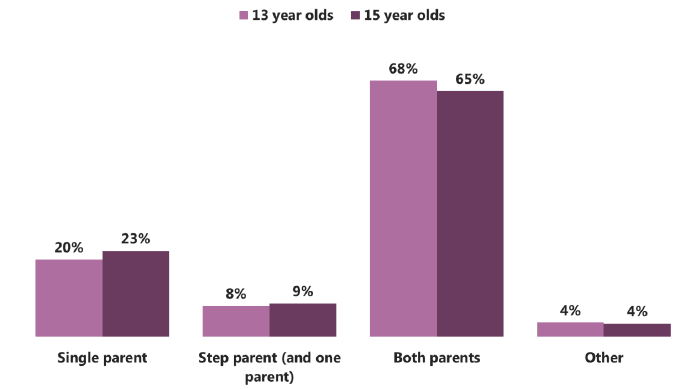
Base: 13 year olds (12,630), 15 year olds (10,910)
Family status has remained largely unchanged between 2006 and 2015. The only change has been a slight increase in the proportion of pupils living with a single parent and a decrease in the proportion living with a step parent and one parent (Figure 5.2).
Figure 5.2 Family status among all pupils (2006-2015)
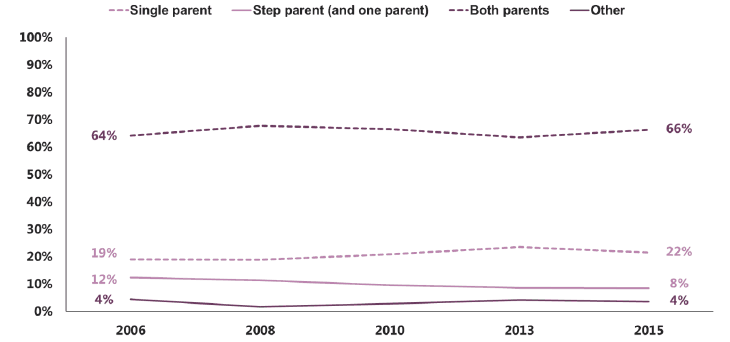
Base: all pupils (for full base sizes please see Appendix A)
Parental knowledge of activities
Pupils are asked how much knowledge ('a lot', 'a little' or 'nothing') their mother and father had about who their friends are, how they spend their money, where they are after school, where they go at night and what they do with their free time. The answers pupils gave to these questions were used to create a composite knowledge score which was then banded into three answer categories: pupils who think their parents who know a lot (an above median [6] composite score) about them, pupils who think their parents know a reasonable amount about them (a median composite score) and those who think they know little about them (a below median composite score).
13 year olds were more likely than 15 year olds to think that their mother knew a lot or a reasonable amount about their activities: 68% of 13 year olds, compared with 57% of 15 year olds.
Among both age groups, girls were more likely than boys to think their mother knew a lot or a reasonable amount about their activities (Figure 5.3).
Figure 5.3 Perceptions of maternal knowledge, by age and gender (2015)
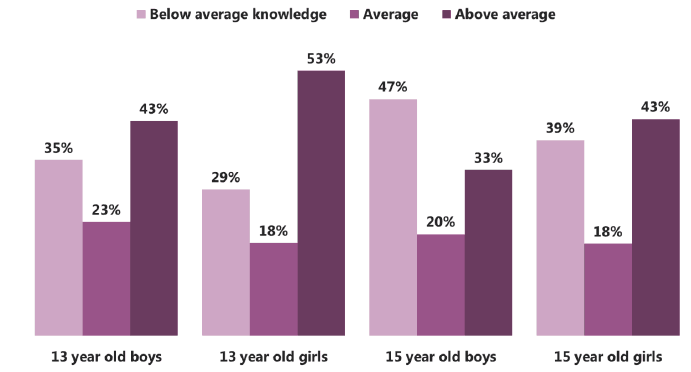
Base: 13 year old boys (6,039), 13 year old girls (6,460), 15 year old boys (5,365), 15 year old girls (5,473)
As with maternal knowledge, 13 year olds were more likely than 15 year olds to think that their father knew a lot or a reasonable amount about their activities. However, in contrast, boys of both age groups were more likely than girls of the corresponding age groups to think that their father knew a lot or a reasonable amount about their activities ( Figure 5.4).
Among both age groups, boys perceived their mother and father to have similar levels of knowledge of what they do and how they spend their time. However, there was a clear difference in perceptions of mother's and father's knowledge among girls. Girls believed that their father knew less about them than their mother ( Figures 5.3 and 5.4).
Figure 5.4 Perceptions of paternal knowledge, by age and gender (2015)
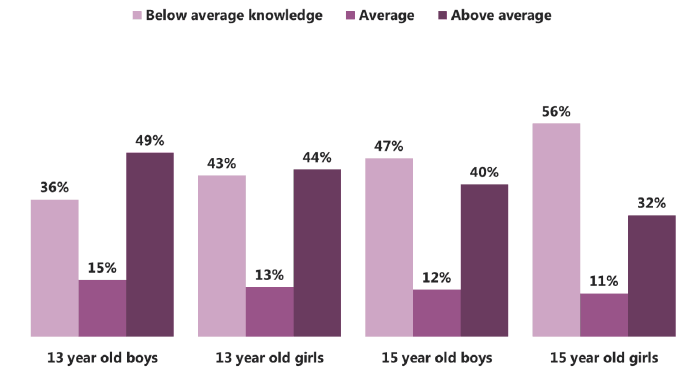
Base: 13 year old boys (6,039), 13 year old girls (6,460), 15 year old boys (5,365), 15 year old girls (5,473)
In order to explore the difference between parental knowledge and gender in more detail we looked at the gender breakdown for the individual items that make up the composite scores.
Overall both boys and girls were most likely to say that their mother knew a lot about where they are after school. For most of the items, girls were more likely than boys to think that their mother knew a lot but the difference between girls and boys were small. The biggest difference between boys and girls was in relation to how much they thought their mother knew about who their friends were (64% off boys thought their mother knew a lot about this, compared with 77% of girls).
Figure 5.5 Proportion of pupils who thought their mother knew a lot about…, by gender (2015)
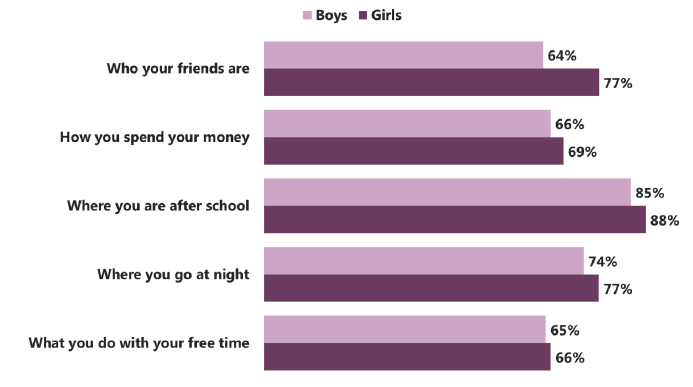
Base: Boys (11,404), Girls (11,933)
As above, both boys and girls were most likely to think that their father knew a lot about where they are after school (64% of boys and 59% of girls). Boys were more likely to think their father knew a lot about each of the items than girls. The greatest difference was in the proportion that thought their father knew a lot about what they do with their free time (59% of boys, compared with 49% of girls).
Figure 5.6 Proportion of pupils who thought their father knew a lot about…, by gender (2015)
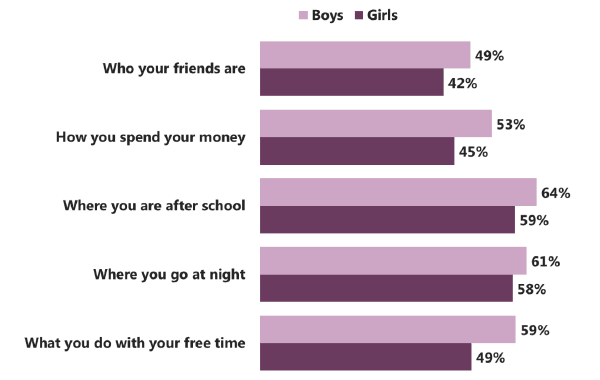
Base: Boys (11,404), Girls (11,933)
Talking about concerns
Across both ages and genders, pupils would be more likely to talk to their mother than father if they were worried about something. There were no gender differences in the likelihood of talking to their mother. However, boys would be more likely than girls to talk to their father if they were worried about something ( Figure 5.7).
13 year olds would be more likely than 15 year olds to talk to their mother (81% of 13 year olds, compared with 72% of 15 year olds) and their father (62% of 13 year olds, compared with 49% of 15 year olds) if they were worried about something.
Figure 5.7 Proportion of pupils who would talk to their mother/father if they were worried about something, by age and gender (2015)
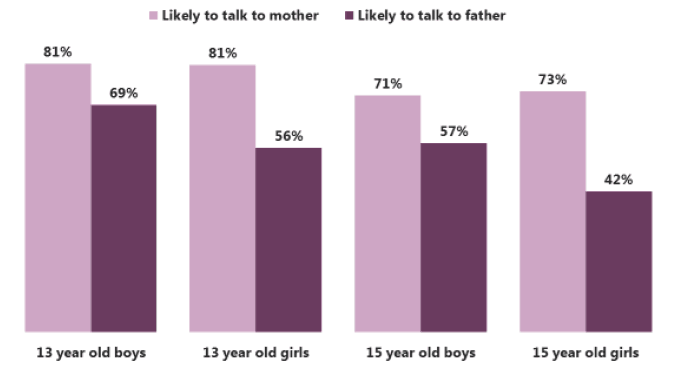
Base: 13 year old boys (6,039), 13 year old girls (6,460), 15 year old boys (5,365), 15 year old girls (5,473)
Caring responsibilities
A new question on caring responsibilities was included in the survey in 2015: 'Do you care for or look after someone in your home because, for example, they have long-term physical/mental ill health/disability? In other words, are you a young carer?'.
Overall, 10% of pupils reported that they were a young carer. There were very few subgroup differences with the exception of 13 year old boys who were slightly more likely to report caring responsibilities than the other groups (Figure 5.8).
Figure 5.8 Proportion of pupils with caring responsibilities, by age and gender (2015)
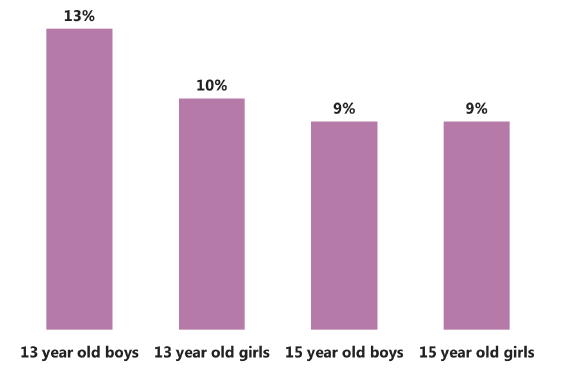
Base: 13 year old boys (6,039), 13 year old girls (6,460), 15 year old boys (5,365), 15 year old girls (5,473)
Contact
Email: Julie Guy
Phone: 0300 244 4000 – Central Enquiry Unit
The Scottish Government
St Andrew's House
Regent Road
Edinburgh
EH1 3DG
There is a problem
Thanks for your feedback